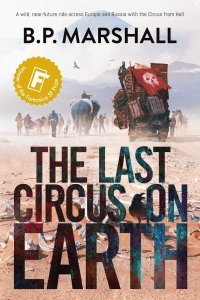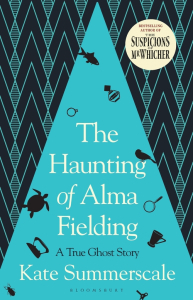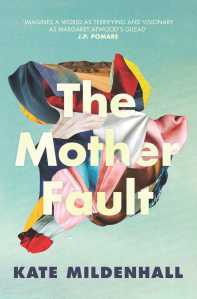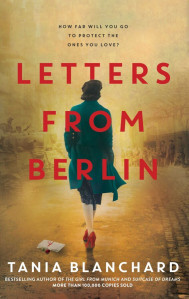Theresa Smith's Blog, page 64
October 24, 2020
The Week That Was…
The scorching summer has arrived here in the outback! Take me back to winter…
[image error]
~~~
Joke of the week:
[image error]
~~~
What I’ve read this week:
[image error]
~~~
What I’ve been watching:
[image error]
I’ve set up a film chat for this one over in my Facebook book club to compliment the Rebecca Buddy Read we had last year. Can’t wait to find out everyone’s opinions on how this film compared to that timeless novel. I did enjoy the film, but they led the viewers to all the answers as opposed to the unsaid manner in which the novel was crafted. It strikes me as perhaps being a version of Rebecca for those who have never read Rebecca. Still well worth watching though, the cinematography is excellent and Manderley is sublime. Brilliant casting as well.
~~~
What I’m reading right now:
[image error]
~~~
Until next week… 
October 22, 2020
Book Review: The Last Circus on Earth by B.P. Marshall
About the Book:

It’s 2070, and the post-Collapse world is staggering toward another, perhaps final, destruction. Blanco, is a reluctant member of Mister Splinter’s Magnifico Cirque de Curiosities. Travelling through dangerous lands, this heavily-armed band of freaks and circus performers survive by conning and killing, robbing and running – and putting on a show.
But simple survival is not their real purpose. Their leader, seen only by his ‘doctors’, enforces brutal rule, and none are more harshly treated than Blanco, who becomes aware the circus is much more than it seems.
Worse, something is growing inside him, something that is changing and killing him. From the ruins of London, across Europe and Asia Minor to the remote Tien Shan mountains, Blanco and the circus fight toward a final showdown, for Blanco’s last chance of survival – and perhaps even for the entire human species.
My Thoughts:
The Last Circus on Earth is at once gripping, more apocalyptic than dystopian, and by far the most science-y of science fiction books I’ve ever read. Mister Splinter’s Magnifico Cirque de Curiosities is not your average circus, more a circus of suffering, a criminal organisation that is also a front for an agenda that takes its time in surfacing within the plot. I have truly never read anything like this before, it’s an absolute mash up of so many things: Mad Max takes on The Hunger Games with an injection of Gattaca while passing through The Island of Dr. Moreau. An absolutely wild and action-packed ride from start to finish.
Marshall is a visual storyteller, from the setting through to his character’s dialect and accents; his writing is imbued with atmosphere. Perhaps this is a by-product of being a scriptwriter, that ability to write with all four senses ignited. While there was a lot more action and brutality within this novel than is to my usual taste, the sophisticated plot and visionary world building more than balanced the scales in favour for my enjoyment. I’m not a huge reader of spec-fiction, but for some reason I’ve been drawn to it of late and my last four reads (including this one) have been from this genre. One thing I look for in a futuristic/dystopian tale is those cautionary messages, particularly around climate change, but this one also dipped into terrain such as unchecked capitalism, political megalomania, religious corruption, genetic manipulation, human robotics, and biological warfare. It sounds like many issues to tackle all at once, but Marshall has strung them all together with such cohesion that he is able to effectively demonstrate through his narrative the ways in which these are all interlinked.
Was this story grim? Absolutely. But sprinkled throughout are moments of human connection that serve as anchors for the characters, and for the readers, encouraging them to stay the course, and the novel does end on a hopeful note. If you’re looking for something truly different to sink into, you might like to give The Last Circus on Earth a try. And what about that cover! It’s sensational, isn’t it? The author has an interview with the cover artist over on his blog and I encourage you to check it out here.




Thanks is extended to the author for providing me with a copy of The Last Circus on Earth for review.
About the Author:
B.P. Marshall is a former Critical Care and Remote Area Nurse who took a break from delivering babies and sewing up machete wounds to consult for a television medical drama. He ended up writing storylines, doing some science journalism and becoming a full-time scriptwriter. A short film, (True Love, Ignition Films), won awards in Australia and the United States. Turning to novels, he won writing mentorships, and was shortlisted (for The Fox) as Emerging Writer in the 2017 Queensland Literary Awards. In 2019 he won the Fantastica Prize for The Last Circus on Earth. He’s currently writing television scripts, and novels across multiple genres.
Find B.P. Marshall online here.
I have had the pleasure of featuring Ben on my blog on two previous occasions. You can read these articles here:
Origin of the Writer: Ben Marshall
Guest Post: Writing War – Truth to Power by Ben Marshall
[image error]
The Last Circus on Earth
Published by Brio Books – Fantastica
Released July 2020
October 19, 2020
Book Review: The Haunting of Alma Fielding by Kate Summerscale
SHORTLISTED FOR THE BAILLIE GIFFORD PRIZE 2020
About the Book:

London, 1938. Alma Fielding, an ordinary young woman, begins to experience supernatural events in her suburban home.
Nandor Fodor – a Jewish-Hungarian refugee and chief ghost hunter for the International Institute for Psychical research – begins to investigate. In doing so he discovers a different and darker type of haunting: trauma, alienation, loss – and the foreshadowing of a nation’s worst fears. As the spectre of Fascism lengthens over Europe, and as Fodor’s obsession with the case deepens, Alma becomes ever more disturbed.
With rigour, daring and insight, the award-winning pioneer of historical narrative non-fiction Kate Summerscale shadows Fodor’s enquiry, delving into long-hidden archives to find the human story behind a very modern haunting.
My Thoughts:
This was quite a fascinating read. Written in the style of narrative non-fiction, The Haunting of Alma Fielding is a ‘true ghost story’ in the sense that it examines an investigative case from the 1930s in which a woman was haunted by a poltergeist. Using the original case notes, the author has put together a truly compelling book that explores the link between psychology and the supernatural played out against the historical backdrop of a nation gripped by fear and loss.
The investigator for this case was a man named Nandor Fodor, who, as the author puts it,
‘was entranced by the idea that individuals contained secret worlds, hidden from themselves, and that supernatural events might be stories to interpret, symbols to decode.’
This book gives a detailed background of Fodor, which aids greatly in understanding what he was trying to achieve concerning Alma Fielding. His interest in Psychical research began early in his adult life, whilst working in New York.
‘He read about spiritualism, a religion that emerged in upstate New York in the middle of the nineteenth century, and about the Society for Psychical Research, founded in England in 1882 to establish a science of the ‘supernormal’. Spiritualists held that the dead survived in another world, and could communicate with the living. Psychical researchers investigated weird experiences to find out whether they were governed by spirits or by natural laws that were not yet understood.’
By the time he moved to Britain, his interest in the field was cemented and his adopted nation proved prime pickings for ghost hunting and the study of mediums.
‘Spiritualism was big business in Britain. Three quarters of a million Britons had been killed in the Great War, and another quarter of a million in the influenza pandemic that followed. Thousands of spiritualist séance circles were established by their widows, widowers and sweethearts, mothers and fathers and children. The faith offered ‘something tremendous’, said Conan Doyle, ‘a breaking down of the walls between two worlds… a call of hope and of guidance to the human race at the time of its deepest affliction.’
I have to say I find this all utterly fascinating from an historical interest point of view. I’m not particularly superstitious myself, but in reality, some of this comes down to fear more than scepticism. Fodor’s interest lay in making connections between the supernatural and trauma, so his research and experiments dipped into psychology regularly. In fact, he consulted with Freud on Alma’s case and was pleased with himself when Freud concurred with his theories. Fodor was a bit ahead of his time though, and quite aggressive in his drive to prove his case, so the majority of his colleagues were put off by the connections he was attempting to make.
‘A ghost was the sign of an unacknowledged horror. It indicated a gap opened by trauma, an event that because it had not been assimilated must be perpetually relived. There were no words, so there was a haunting.’
~~~
‘In effect, Fodor’s psychical research had transmuted into a study of abnormal psychology; he was suggesting that supernatural power was a function of mental breakdown.’
~~~
‘Fodor had noticed that supernatural events were unusually able to communicate the splintering and contradiction of a traumatic experience.’
~~~
‘Since the 1980s, researchers in the psychology of supernatural belief have found a correlation between childhood trauma and adult experiences of paranormality. People who have been sexually abused as children are unusually likely to report supernatural events. Psychologists speculate that damaged children learn to use fantasy as a form of escape, while their desperate wish for control generates delusions of psychic power.’
Specifically on Alma Fielding, what an interesting case this was. There was evidence of both fraud and the unexplained and in essence, no one was ever really able to determine the entire truth of the matter. Fodor was certain as time went on though, that Alma had repressed abuse from childhood.
‘Alma had a strong masochistic drive, Fodor observed: she played a double role, as aggressor and victim. But then he, too, had taken a double role, as Alma’s champion and her inquisitor. In the course of the investigation, their relationship had acquired a sadomasochistic shape, admiration and desire becoming entangled with secrecy, deceit and control.’
~~~
‘In Fodor’s account, both Alma’s eerie experiences and her fraud were explained by the damage done to her in childhood. His theory made haunting consistent with psychoanalysis: not a counter-argument that suggested that some gifted individuals could make contact with another world or with their subliminal selves, but a proof of the uncanny power of repression.’
Interestingly, the author makes a connection within Alma’s case that Fodor seems to have overlooked: the loss of her child to tubercular meningitis at age one. She also miscarried twins late in pregnancy. These losses had a profound effect on her and there were clear connections between anniversaries of the deaths and supernatural incidents occurring. Alma had also had incredibly bad luck with her health and had had multiple operations under anaesthetic, including a mastectomy, and by her own accounts, each of these operations had been traumatic, along with the ongoing health issues surrounding them. Perhaps Fodor was right about the trauma connection, but barking up the wrong tree about the origin of the trauma. Again, something that no one will ever know, but it certainly was interesting reading all about it.




Thanks is extended to Bloomsbury for providing me with a copy of The Haunting of Alma Fielding for review.
About the Author:
Kate Summerscale is the author of the number one bestselling The Suspicions of Mr Whicher, winner of the Samuel Johnson Prize for Non-Fiction 2008, winner of the Galaxy British Book of the Year Award, a Richard & Judy Book Club pick and adapted into a major ITV drama. Her first book, the bestselling The Queen of Whale Cay, won a Somerset Maugham award and was shortlisted for the Whitbread biography award. Kate Summerscale has also judged various literary competitions including the Booker Prize. She lives in north London.
[image error]
The Haunting of Alma Fielding
Published by Bloomsbury Circus
Released 29th September 2020
October 17, 2020
The Week That Was…
You have to wonder sometimes…
[image error]
~~~
What I’ve read this week:


~~~
Joke of the week:
[image error]
~~~
What I’ve been watching:
The fourth and final season. Such compelling viewing! I’m enjoying the way in which morality is examined through the use of speculative fiction throughout this series.
[image error]
~~~
Until next week… 
October 14, 2020
Book Review: The Perfect World of Miwako Sumida by Clarissa Goenawan
About the Book:

A bewitching novel set in contemporary Japan about the mysterious suicide of a young woman.
Miwako Sumida is dead.
Now those closest to her try to piece together the fragments of her life. Ryusei, who has always loved her, follows Miwako’s trail to a remote Japanese village. Chie, Miwako’s best friend, was the only person to know her true identity — but is now the time to reveal it? Meanwhile, Fumi, Ryusei’s sister, is harbouring her own haunting secret.
Together, they realise that the young woman they thought they knew had more going on behind her seemingly perfect façade than they could ever have dreamed.
My Thoughts:
This was a really interesting novel. I was quite taken with it and found it hard to put down. It’s an absorbing story about a young woman named Miwako Sumida and how three of her closest friends try to make peace with her suicide. The novel is split into three parts, with each of these parts offering a different perspective, along with clues as to who Miwako really was, so that by the time you reach the end, a clearer picture of Miwako has emerged.
First, Ryusei, who was in love in with Miwako. Second, Chie, Miwako’s best friend, the one who has known her the longest. And third, and perhaps most curiously, Fumi, Ryusei’s sister, who actually didn’t know Miwako all that well at all, but whose perspective offered a somewhat different and more spiritual outlook. With Ryusei and Chie, the sections are filled with their reminiscences about Miwako, fond memories as well as ones that they recall in a bid to try and piece together the reason why Miwako may have chosen to end her own life. In Chie’s section, she and Ryusei take a pilgrimage together to the mountains in order to visit the place where Miwako ended her life, in a bid to help them both understand what happened. The trip ends up becoming more about the journey and making peace than actually uncovering any real answers. Fumi’s section is entirely different and it takes some time to establish the connections at all. When they do reveal themselves, you will find yourself quite surprised. As I already mentioned, this section is rather spiritual, it dips into very mystical terrain that might not work for all readers. Personally, I really liked it. It was unique and it offered a sense of closure that would have not otherwise been possible.
The author is an Indonesian born Singaporean and the novel is set in Japan with Japanese characters. My impression, based on the little I know of the more mystical elements of Japanese culture, is that what occurs within Fumi’s section is not necessarily out of the realms of possibility. Or, perhaps it’s completely made up. Either way, I never mind the inclusion of mystical elements within a story, so it all worked for me. This novel was very absorbing and incredibly well written, the way it dipped in and out of the present and the past; and Fumi’s section, how that all played out was rather clever indeed, steering us in several directions prior to the revealing moment. On Fumi, there was a story within the story with this character that I really appreciated. The issues touched on were done so with precision and empathy and Fumi’s experiences, particularly within her night job, opened my eyes to a few specific things that I hadn’t known about Japan.
The Perfect World of Miwako Sumida is above all an intricate character examination of the effects of suicide on those closest to the departed. It was sensitively drawn out and captured the essence of being young in Japan in the late 1980s/early 1990s. Highly recommended and I’ll be looking out for more from this author.




Thanks is extended to Scribe for providing me with a copy of The Perfect World of Miwako Sumida for review.
About the Author:
Clarissa Goenawan is an Indonesian-born Singaporean writer. Her debut novel Rainbirds won the 2015 Bath Novel Award and was shortlisted for three further prizes. Her short stories have won several awards and been published in various literary magazines and anthologies. The Perfect World of Miwako Sumida is her second novel.
[image error]
The Perfect World of Miwako Sumida
Published by Scribe
Released 29th September 2020
October 13, 2020
Author Talks: Sue Williams on discovering two remarkable friends and their shared story of changing the world, one patient at a time
I first met Australian icon Dr Catherine Hamlin when I went travelling in Ethiopia at the end of 2017. I spent a few days at the Addis Ababa Fistula Hospital talking to her for a magazine article, and learning about her tremendous work caring for girls and women who were suffering debilitating childbirth injuries, and effectively giving them back their lives.
No one could fail to be touched by the sight of so many young women at the hospital, arriving with downcast eyes, suffering the grief of losing a baby and the terrible horror and shame afterwards of not being able to control their bodily functions. And then be uplifted by their sheer joy as they later left the hospital, cured, and ready to reclaim their interrupted lives.
While there, I met Catherine’s great friend, Ethiopian surgeon Mamitu Gashe. Mamitu was quite shy, and didn’t talk much, disappearing whenever I approached. I was intrigued, and asked about her story.
What I learned amazed me. Mamitu had been a poor, uneducated village girl from high in the mountains of Ethiopia who herself had been devastated by a long, long labour that had caused fistula, and who’d been carried down the high escarpment on a stretcher made from eucalyptus branches to Catherine’s hospital.
There, she was treated with such love and care, she was completely overwhelmed and, in gratitude, started working around the hospital.
Mamitu’s story had never been told before as she was too humble to want any public recognition. But eventually she agreed to share the tale of her life, her child marriage and the tragic pregnancy that, at one stage, threatened to rob her completely of a future.
[image error]
I booked to return to Ethiopia to spend a few weeks with her talking about her story, and visiting her old village and meeting her family. But then came COVID-19, the world closed down, and my flights were cancelled. So we were forced to do all our interviews over Zoom.
We talked long into many nights – with the help of an interpreter – and the more I learned, the more fascinated I became. Mamitu began at the hospital mopping floors and making beds, and progressed to helping out in the operating theatre. Gradually, she became absolutely indispensable to Catherine and her husband Reg, during Hailie Selassie’s rule, the Communist coup that felled him, the ‘Red Terror’ massacres that followed, and the years of terrible famine.
Finally, she showed such skill and flair, she progressed to assisting the surgeons with their operations. And eventually, she began operating herself, winning awards from around the world for her work.
Today, it’s said there’s no one performing fistula surgery anywhere on earth that hasn’t been either taught by Mamitu or taught by someone who was taught by Mamitu.
She’s been hailed as the barefoot surgeon leading the way for the future of medicine in the developing world, an expert in her field even though she still cannot read or write, and the closest friend of Catherine Hamlin.
Writing this book, and being allowed into the lives of Catherine and Mamitu, and their great friendship that has saved so many young girls and women, felt like a real privilege, and one I will treasure for the rest of my life.
Healing Lives
[image error]
Two incredible women, an unlikely friendship, and a united mission to save the lives of some of the world’s poorest and most desperate women.
Healing Lives reveals the untold tale of Mamitu Gashe, Dr Catherine Hamlin’s protégée, and the inspiring almost 60-year friendship between the two women.
In 1962, three years after Drs Catherine and Reg Hamlin arrived in Ethiopia, an illiterate peasant girl sought their aid. Mamitu Gashe was close to death and horrifically injured during childbirth after an arranged marriage – at the age of just fourteen to a man she’d never met – in a remote mountain village.
The Hamlins’ Addis Ababa Fistula Hospital saved her and, in return, Mamitu dedicated her life to Catherine’s mission. Under the iconic doctor’s guidance, Mamitu went from mopping floors and comforting her fellow patients, to becoming one of the most acclaimed fistula surgeons in the world, despite never having had a day’s schooling.
This is the moving story of the friendship that saved the lives of over 60,000 of the poorest women on earth.
Published by Pan Macmillan Australia
Released 13th October 2020
Rrp: $34.99
About Sue Williams
[image error]
Sue Williams is an award-winning journalist, travel writer and best-selling author of 23 books. Previous biographies by Sue include Mean Streets, Kind Heart: The Father Chris Riley Story; Father Bob, the larrikin priest; The Last Showman Fred Brophy; No Time for Fear, Paul de Gelder; The Girl Who Climbed Everest, and a number of books about Australian outback characters. Sue, originally from the UK but living in Australia for 30 years, has also spent much of her life travelling in Africa, and wrote one book based mostly there, Getting There: Journeys of an Accidental Adventurer. She returns regularly.
October 12, 2020
Book Review: The Mother Fault by Kate Mildenhall
About the Book:

Imagining a near future as terrifying as Margaret Atwood’s Gilead, a riveting tale of one woman taking on the world to save her own.
You will not recognise me, she thinks, when I find you . . .
Mim’s husband is missing. No one knows where Ben is, but everyone wants to find him – especially The Department. And they should know, the all-seeing government body has fitted the entire population with a universal tracking chip to keep them ‘safe’.
But suddenly Ben can’t be tracked. And Mim is questioned, made to surrender her passport and threatened with the unthinkable – her two children being taken into care at the notorious BestLife.
Cornered, Mim risks everything to go on the run to find her husband – and a part of herself, long gone, that is brave enough to tackle the journey ahead.
From the stark backroads of the Australian outback to a terrifying sea voyage, Mim is forced to shuck off who she was – mother, daughter, wife, sister – and become the woman she needs to be to save her family and herself.
My Thoughts:
What a diverse writer Kate Mildenhall is! I read – and loved – her debut novel, Skylarking, which was literary historical fiction. Here she is now with her second release, The Mother Fault, an absorbing blend of science fiction with eco-literature; the type of dystopian world building that is uncomfortably, and frighteningly, familiar in terms of global projection.
The Mother Fault reads like a pacey dystopian thriller, but take note of the setting, the state of the country that Mim is travelling through, and you have a significant work of eco-literature, the representation of a planet in crisis. It’s this world building, alongside the compelling plot peopled by realistic characters that makes this novel a standout read.
At the same time as reading this, I began watching a television series called The Man in the High Castle, a dystopian thriller that gives an alternate view of the world post WWII; a world in which the Nazis and the Japanese were victorious and had subsequently split the world between them. Although set almost 100 years apart, the ‘Department’ Stasi style of control over society, the ever-present daily fear, the notorious ‘BestLife’ estates which mirrored Nazi purification policies; there were more similarities than differences between this novel and that show. A society where we are all microchipped, tracked and controlled, powerless when something goes wrong. Funds cut off, children removed from your care, your passport confiscated; every move you make seen and recorded. Truly frightening to behold.
At the heart of this novel though is an intricate and deeply meaningful story about motherhood. Mim is entirely relatable as a character. Kate examines in great depth through Mim’s characterisation the many ways in which we as mothers constantly judge ourselves and count our failings above our successes. The fierce love of a mother when her children are under threat forms the basis of all of Mim’s actions throughout the novel. Her irrationality is entirely rational when viewed from a cornered and fearful mother’s perspective. I could only hope that I might be as brave as Mim if I ever found myself in the same situation.
Seriously, this is an excellent novel. There is an element of sustained dread maintained throughout that mounted towards the end, so expect to not be able to put this one down once you reach that point. The ending approaches fast and fierce, almost in a shocking manner, which really mimics the way it is for the characters as well. Ultimately, the novel finishes up on a hopeful note, although the underlying messages were definitely still ringing loudly in my ear. Compelling reading that I highly recommend to all.





Thanks is extended to Simon & Schuster Australia for providing me with a copy of The Mother Fault for review.
About the Author:
Kate Mildenhall is a writer and teacher. Her debut novel, Skylarking, was named in Readings Top Ten Fiction Books of 2016 and longlisted for Best Debut Fiction in The Indie Book Awards 2017 and the 2017 Voss Literary Prize. Kate teaches creative writing to young writers and co-hosts The First Time, a podcast about the first time you publish a book. The Mother Fault is her second novel. Kate lives with her partner and two daughters in Hurstbridge, Victoria.
Find out more about Kate at katemildenhall.com
[image error]
The Mother Fault
Published by Simon & Schuster Australia
Released 2nd September 2020
October 11, 2020
#BlogTour #BookReview: Letters from Berlin by Tania Blanchard
About the Book:

Berlin, 1943
As the Allied forces edge closer, the Third Reich tightens its grip on its people. For eighteen-year-old Susanna Göttmann, this means her adopted family including the man she loves, Leo, are at risk.
Desperate to protect her loved ones any way she can, Susie accepts the help of an influential Nazi officer. But it comes at a terrible cost – she must abandon any hope of a future with Leo and enter the frightening world of the Nazi elite.
Yet all is not lost as her newfound position offers more than she could have hoped for … With critical intelligence at her fingertips, Susie seizes a dangerous opportunity to help the Resistance.
The decisions she makes could change the course of the war, but what will they mean for her family and her future?
My Thoughts:
Letters from Berlin is the third novel from Australian author, Tania Blanchard, but the first that I’ve read. The author has drawn on her own family history and the result is a deeply moving portrayal of life in Berlin and its surrounding communities during the final years of WWII and the tumultuous aftermath of occupation preceding the division of Berlin into East and West.
‘Nazi propaganda and the war had turned former friends and acquaintances into bitter, resentful and untrusting people afraid for their own survival.’
I really liked this inside view on Berlin during this volatile period. As the war drew closer to its end, Nazism took on an intensity that dipped into madness, and combined with the fear of the advancing Russian army, Berliners were trapped in a city that was being destroyed and betrayed in equal measure. This novel is a slow burn historical, taking its time to lay out the history, set the scene, and develop the characters. It’s a compelling read, many of the events playing out with a dreadful inevitability that you couldn’t help but foresee.
This novel intricately explores what it was like to be a German against Nazism. To mourn the losses of your country, to be horrified by the violence within, repelled by the actions of your neighbours and former friends. After all of the suffering throughout the years of the war, for Germany, the end was only a new beginning of a different kind of suffering. For some, this would prove to be too much and the loss too significant. For others, the dream of a unified Germany would sustain until it prevailed. Recommended reading.




Thanks is extended to Simon & Schuster Australia for providing me with a copy of Letters from Berlin for review and for inviting me onto the blog tour.
[image error]
About the Author:
Tania Blanchard was inspired to write by the fascinating stories her German grandmother told her as a child. Coming from a family with a rich cultural heritage, stories have always been in her blood. Her first novel published by Simon & Schuster Australia, The Girl from Munich, was a runaway bestseller, as was the sequel, Suitcase of Dreams. Tania lives in Sydney with her husband and three children.
[image error]
Letters from Berlin
Published by Simon & Schuster Australia
Released 7th October 2020
October 10, 2020
The Week That Was…
Now, I’m not asking for confessions or anything, but I’ll just leave this here for contemplation…
[image error]
~~~
Book of the week:
[image error]
~~~
Joke of the week:
[image error]
~~~
What I’ve been watching:
[image error]
[image error]
Finished seasons one and two and I’m now at the beginning episodes of season three. There’s a speculative aspect to this show that wasn’t apparent until the second season: parallel universes. When it comes to TV, I really do enjoy both time travel and parallel universes. I haven’t been as absorbed in such a complex show since 12 Monkeys. I’m loving it, there’s no room to drift while watching, you need to keep your eye and mind engaged with it at all times, which is something I really need right now.
~~~
What I’m reading right now:
[image error]
~~~
Until next week… 
October 9, 2020
#BookBingo2020 – Round 10: Themes of Culture
[image error]
Stone Sky Gold Mountain is an unforgettable story, gentle in its brutality as it inches closer to its tragic inevitability. It is a study of prejudice, displacement, racism, and misogyny. You really didn’t want to be anything other than a white man in 19th century Australia.
Visit my full review of this book here.
[image error]
I’ve teamed up once again with Mrs B’s Book Reviews and The Book Muse. It’s going to be a little different for 2020, the card has less squares, allowing us to run bingo on the second Saturday of each month. Also, for the first time since beginning bingo, I haven’t specified genre, type, or even fiction or non-fiction for the categories. 2020 is all about themes, and from there, the choice is wide open.
Hope to see you joining in! If you want to play along, just tag us on social media with your bingo posts each month. You can also join the Page by Page Book Club with Theresa Smith Writes over on Facebook, where we all post in the same place on the same date and chat over each other’s entries. Alternatively, drop a link each month into the comments of my Saturday bingo post so I can follow your progress blog to blog.
#BookBingo2020



